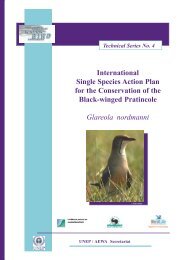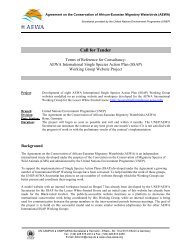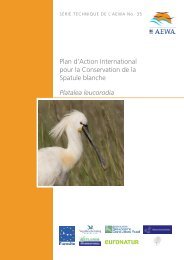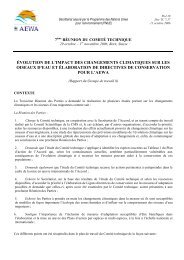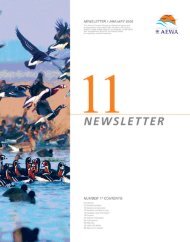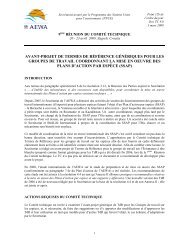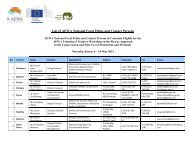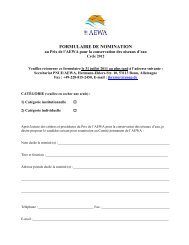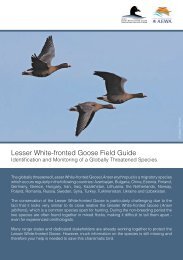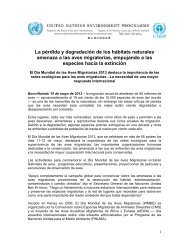International Single Species Action Plan for the ... - AEWA
International Single Species Action Plan for the ... - AEWA
International Single Species Action Plan for the ... - AEWA
Create successful ePaper yourself
Turn your PDF publications into a flip-book with our unique Google optimized e-Paper software.
<strong>AEWA</strong> Technical Series No. 36 - Annexes<br />
Supporting in<strong>for</strong>mation to use in conjunction with <strong>the</strong> table<br />
The following is a summary of <strong>the</strong> most up-to-date in<strong>for</strong>mation available on <strong>the</strong> status and<br />
trends of Lesser White-fronted Goose in each country, divided into Principal Range States<br />
(i.e. those countries that are known regularly to support breeding, moulting, staging or<br />
wintering Lesser White-fronted Geese) and o<strong>the</strong>r countries of <strong>the</strong> <strong>AEWA</strong> Agreement Area<br />
and European Union (i.e. where <strong>the</strong> species is currently a rare visitor or vagrant).<br />
(a) Principal Range States<br />
Azerbaijan<br />
Vernacular name: Ahgash gaz<br />
UNEP/WCMC 2004 summarised <strong>the</strong> species status as: “A winter visitor recorded from <strong>the</strong><br />
coast, Kizil Agach and <strong>the</strong> Kura River lowlands (Lorentsen et al., 1999; Shelton, 2001). A<br />
total of 1,085 individuals were counted in a survey conducted in 1996 and it was suggested<br />
that <strong>the</strong> wintering population varied between 1,500 and 7,000 (Aarvak et al., 1996; Paynter,<br />
1996). About 25,000 birds were reported in 1978, 1980 and 1982/83 but <strong>the</strong> numbers steadily<br />
declined in subsequent winters (Morozov and Poyarkov, 1997; Tkachenko, 1997)”.<br />
The species’ present status is unclear, owing to a lack of systematic count data. However, it<br />
seems likely that <strong>the</strong> country may remain an important wintering site <strong>for</strong> <strong>the</strong> Western main<br />
population, given that in March 2001 large staging flocks were found in <strong>the</strong> Kyzyl Agach area<br />
(565 birds) and in <strong>the</strong> Ag-Gel Zapovednik (1,800 - 2,000 birds). In both cases <strong>the</strong> Lesser<br />
White-fronts were observed in mixed flocks with Greater White-fronted and Greylag Goose<br />
feeding on meadow vegetation. A calling bird was heard at Lake Shorgel and 6 individuals<br />
were seen at Divichi Lima, indicating that <strong>the</strong>se areas may also be important sites <strong>for</strong> that<br />
species (Heinicke & Ryslavy 2002).<br />
A satellite-tagged bird of <strong>the</strong> Western main subpopulation, ringed in <strong>the</strong> Polar Ural region of<br />
nor<strong>the</strong>rn Russia in August 2004, staged in Azerbaijan <strong>for</strong> several days in November 2004<br />
be<strong>for</strong>e continuing its migration, via eastern Turkey, to winter in Iraq. (source:<br />
www.piskulka.net/Satellite tracking.htm)<br />
Bulgaria (EU)<br />
Vernacular name: Malka belochela gaska<br />
A 1996 survey estimated <strong>the</strong> total number of Lesser White-fronts in Bulgaria as 30-40<br />
(Aarvak et al. 1996), whereas Petkov et al. (1999) estimated a total of 100 birds.<br />
Lesser White-fronts occur regularly in small numbers at traditional goose staging and<br />
wintering sites on <strong>the</strong> Black Sea coast, notably at Lake Shabla and Lake Durankulak, both of<br />
which are Ramsar Sites and Important Bird Areas. However, recent count data are inadequate<br />
<strong>for</strong> <strong>the</strong>se sites to qualify as IBAs <strong>for</strong> Lesser White-fronted Goose (S. Nagy/BirdLife<br />
<strong>International</strong>, pers comm), hence <strong>the</strong>y are not listed in Annex 3. The last adequate count was<br />
conducted in 1998 by a BirdLife Bulgaria/BirdLife Norway team, which estimated some 100<br />
birds present in <strong>the</strong> area of Shabla and Durankulak Lakes. In recent years <strong>the</strong>re has been no<br />
targeted count or research <strong>for</strong> this species. Goose counts are made only during <strong>the</strong> morning<br />
when <strong>the</strong> birds leave roosting sites and this does not allow identification of LWfG among <strong>the</strong><br />
tens of thousands Greater White-fronts. However, casual birdwatchers regularly report <strong>the</strong><br />
species (e.g. in February/March 2005, some 3 to 5 birds were identified in a flock of 1,200<br />
Greater White-fronts at Durankulak Lake), suggesting that over 100 may occur when flocks<br />
<strong>International</strong> <strong>Single</strong> <strong>Species</strong> <strong>Action</strong> <strong>Plan</strong> Lesser White-fronted Goose –Annexes<br />
VIII



